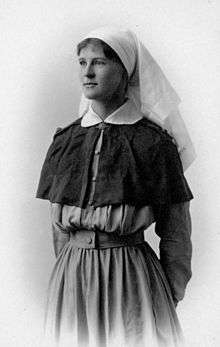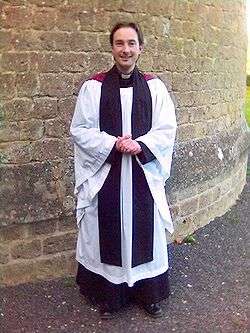Tippet

A tippet is a scarf-like narrow piece of clothing, worn over the shoulders. It may also be likened to a stole in the secular rather than ecclesiastic sense of this word. Tippets evolved in the fourteenth century from long sleeves and typically had one end hanging down to the knees. In later fashion, a tippet is often any scarf-like wrap, usually made of fur, such as the sixteenth century zibellino[1] or the fur-lined capelets worn in the mid-18th century.
Ecclesiastical use
The ceremonial scarf worn by Anglican priests is called a tippet. The tippet is worn with choir dress and hangs straight down at the front. Ordained clergy wear a black tippet, while licensed readers wear a blue one. In some countries it is normally simply referred to as a preaching scarf, black scarf, or blue scarf. The tippet is different from the stole, which although often worn like a scarf is a Eucharistic vestment, usually made of richer material, and varying according to the liturgical colour of the day. Clergy who are entitled to wear medals, orders or awards may fix them to the upper left side of the tippet on suitable occasions (Remembrance Sunday for example). Sometimes the right end of the tippet is embroidered with the coat of arms of the ecclesiastical institution of which the cleric is a member, but some deplore this usage. Tippets are often worn for the Daily Offices of Morning Prayer and Evensong. (Cf. Canon B8 of the Church of England, nb. the word "Scarf" is referring to the Tippet)[2] Stricter low church clergy may wear the tippet and choir dress during any church service, whether Communion is celebrated or not. This follows a practice that was enforced from the Reformation until the late 19th century. By contrast, Anglican Catholics tend not to wear the tippet, often preferring to wear the choir habit of Roman Catholic clergy instead.
Some Lutherans use the tippet, as well. Members of the Society of the Holy Trinity wear a tippet embroidered with the Society's seal when presiding at the daily office.
The black preaching scarf (rarely blue, grey or green) is also worn by some Scottish Presbyterian ministers and other non-conformist clergy. Members of Church Army - a Dispersed Community of Evangelists within the Church of England - are presented with a Cherry Red (maroon)'Collar' type Tippet, on their Commissioning, as a sign of authority to preach. Some Officers replace this with a Scarf form of the tippet, but retaining the distinctive color scheme.
British military nurses
A different and non-religious sort of tippet, a shoulder-length cape, has been part of the uniform of British military nurses or of nursing uniforms in Commonwealth countries. These are often decorated with piping and may have badges or insignia indicating the wearer's rank.

Evolution of the tippet
 Fourteenth century fur-lined tippet or hanging sleeve
Fourteenth century fur-lined tippet or hanging sleeve Sixteenth century zibellino or fur tippet
Sixteenth century zibellino or fur tippet Eighteenth century fur-lined tippet or capelet
Eighteenth century fur-lined tippet or capelet Reverend Brent Hawkes wearing a tippet with the colours of the rainbow flag in the twenty-first century
Reverend Brent Hawkes wearing a tippet with the colours of the rainbow flag in the twenty-first century
Notes
- ↑ Arnold, Janet: Queen Elizabeth's Wardrobe Unlock'd, W S Maney and Son Ltd, Leeds 1988. ISBN 0-901286-20-6
- ↑ http://www.churchofengland.org/media/35588/complete.pdf
References
- Arnold, Janet: Queen Elizabeth's Wardrobe Unlock'd, W S Maney and Son Ltd, Leeds 1988. ISBN 0-901286-20-6
- Netherton, Robin, "The Tippet: Accessory after Fact?", in Robin Netherton and Gale R. Owen-Crocker, editors, Medieval Clothing and Textiles, Volume 1, Woodbridge, Suffolk, UK, and Rochester, NY, the Boydell Press, 2005, ISBN 1-84383-123-6
- Payne, Blanche: History of Costume from the Ancient Egyptians to the Twentieth Century, Harper & Row, 1965. No ISBN for this edition; ASIN B0006BMNFS
- Dickinson, Emily, "My Tippet - only Tulle -", in Because I could not stop for Death, Poems, Robert Brothers of Boston, 1890
